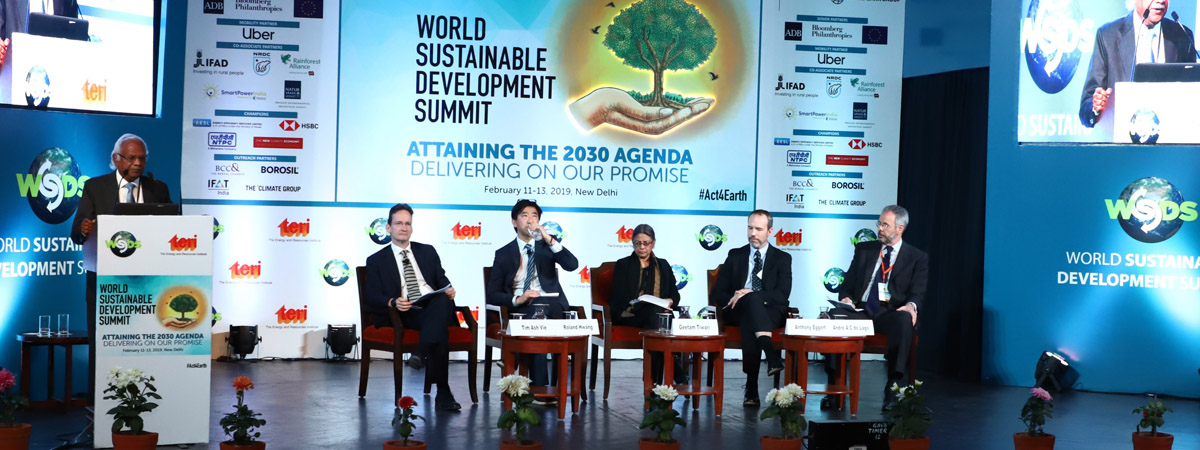Shared, public and electric mobility will drive India towards sustainable transport

The core purpose of mobility is to provide transport solutions at an affordable price. Everything else that we plan around it must be done with this holistic picture in mind - these were the thoughts of Mr Manu Saxena, Vice-President Business Planning, TVS Motor Company, at the plenary session on ‘Mobility in Developing Countries’ at WSDS 2019. Sustainable mobility can be achieved through the framework of shared mobility, public transport and electric vehicles, and this is precisely where urban planning plays a major role in terms of creating infrastructure and allocating good quality open spaces. With 70% of India yet to be built by 2030, and the rate of motorisation progressing at 7-8% (higher than the global average), India as an emerging economy has a major opportunity ahead to develop its transport infrastructure through National Urban Policy, Smart Cities, and several other mega programmes.
Rapid urbanisation also means that a large number of roads and the vehicles that will ply on them are yet to be built. This includes intra-city transport, and points to the urgent issue of managing road congestion, lack of parking spaces, and lack of affordable modes of transport. Through cab aggregators such as Uber, these issues are being addressed to some extent. However, the current array of services that they offer is being availed by a miniscule section of the urban population and only in select cities. Thus, a large section of the population in tier I, II and III cities is bereft of sustainable transport choices. Introducing multi-modal solutions that cater to even the last mile connectivity are, therefore, an imperative.
It is here that the untapped potential of sustainable mobility in the form of non-motorised transport (NMT) needs to be explored. States like Goa, which is already in the process of creating 75km of bicycle tracks, understand the need of the hour and the fact that people must use bicycles by choice as a safe option and not as a compulsion. Put in the right perspective, it should complement rather than supplement available motorised public transport. If the numbers revealed in a recent TERI report on the benefits of cycling are anything to go by then shifting only half of all the short-distance work trips, which typically take place through cars and two-wheelers, to cycling can result in annual savings of up to 1.6% of India’s GDP. Another figure in point is the average speed of vehicles in most urban areas which has dropped to 17kmph as per a recent study. Against this background, it is worth bringing in NMT at a large scale. As H.E André Aranha Corrêa do Lago, Ambassador of Brazil to India, pointed out during a panel discussion at WSDS, India has the advantage of developing transport solutions at scale – whether it is experimenting with biofuels or electric vehicles. He also said that as the largest producers of sugarcane, both Brazil and India can harness the power of ethanol for various applications.
Currently, 90% of the energy used in transportation, for both goods and people, is supplied through fossil fuels. With the right boost to electric vehicles, carbon emissions are expected to reduce despite apprehensions that electricity required to charge the batteries of these vehicles may need to be drawn from thermal power plants during peak hours. However, given that the current average time required to charge a vehicle is an hour, enhancing battery storage capacity and alleviating user anxiety related to availability of charging infrastructure will be of primary concern as we look to scaling up uptake of electric vehicles.
Thus infrastructure is of immense importance, whether it is electric vehicles or non-motorised solutions. It will play a crucial role in changing public perception towards mobility. The same strain of thought also continues to dominate the space of shared mobility in India, which has picked up interest in the recent years. Here, gender inclusivity poses a question in the absence of a secure framework within which a vehicle operates. Fear of unknown co-passengers, absence of well-lit roads for last mile connectivity - all contribute to inhibitions towards fully adopting the shared mode. While systemic change is one aspect to be dealt with, policy change is another. The current regulations do not allow private cars to be used as pool cabs. To encourage the uptake of shared mobility, such regulations need to be modified so that private car owners use their vehicle to offer rides to neighbours and colleagues, thus addressing multiple transport concerns. Just as bicycling is expected to offer various direct and indirect economic and health benefits, similarly, shared mobility can save 1.5 gigatonnes of carbon emissions.
Given the immense benefits that these modes offer, a seamless integration of all three forms of transport is important to provide the user with an enhanced and efficient means of travelling, and boost the economy. This integration must also include railways in its big picture. As the widest network of transport mode in the world, railways provide one of the most sustainable modes of transportation for both people and goods. Its integration with the intra-city modes needs to be looked at in far greater detail along with infrastructural modifications. While over the years, the share of freight for railways has come down owing to its own inability to the burgeoning needs of the manufacturing sectors, and the creation of road networks, there is a need to boost this share from the current 30% in order to reduce carbon emissions and save transportation costs of goods.